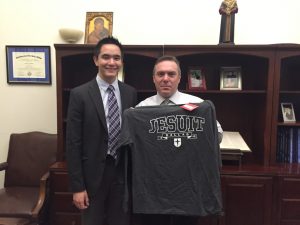“It was the best of times, it was the worst of times…” these iconic lines ran through my head as I walked into the Xavier High School entryway, shivering from the biting New York cold. On its surface, Xavier appears nothing like Jesuit, each space optimized to serve countless functions, missing the sprawling athletic fields characteristic of 12345 Inwood Road. Legends have gradated from the school like former Supreme Court Justice Antonin Scalia and Today show weather host Al Roker, and scenes from popular shows like Netflix original Unbreakable Kimmy Schmidt were shot on campus. Beyond these physical differences, however, lies a pair of matching communities committed to the same values and offering a quality of education that is unparalleled.
Over 150 years ago, Xavier was founded along with Regis High School, Loyola School, Fordham Preparatory School, and St. Peter’s Preparatory School in Jersey City as the five Jesuit high schools within New York City. Both the school and St. Francis Xavier Church were created alongside each other, and at one point the school owned almost two city blocks worth of land. Xavier holds a longstanding commitment to being physically fit, the only school other than Loyola New Orleans to still have a ROTC program. They even boast an underground air rifle range, something that a Texas school ironically does not have. Unlike Jesuit where most classes are either in the main school building or the Terry Center, the Xavier campus is made up of five separate buildings combined into one. The only way to tell them apart? When the floor color changes, you have entered a different building.
within New York City. Both the school and St. Francis Xavier Church were created alongside each other, and at one point the school owned almost two city blocks worth of land. Xavier holds a longstanding commitment to being physically fit, the only school other than Loyola New Orleans to still have a ROTC program. They even boast an underground air rifle range, something that a Texas school ironically does not have. Unlike Jesuit where most classes are either in the main school building or the Terry Center, the Xavier campus is made up of five separate buildings combined into one. The only way to tell them apart? When the floor color changes, you have entered a different building.
Mr. Mike Livigni, Xavier’s Headmaster, fills the same role as Mr. Tom Garrison here at Jesuit Dallas. One of the memories he shared was his son’s humorous observation that “you have the easiest job because you just sit in that big comfy chair and answer emails all day!” Although these responsibilities may appear like nothing to a child, each day Livigni’s job requires active involvement in the community, as he notes “I take care of the day to day stuff, I make sure that teachers are doing what they’re supposed to be doing, that students are doing what they’re supposed to be doing, and everyone is learning and being educated.” One of the things that make his job so appealing is that he “honestly [doesn’t] know what will happen in a given day.” Mr. Livigni’s commitment to his students goes beyond simple administrative work, and one of the highlights of his day is teaching his English class. While both principals/headmasters teach in very different environments, the two share a unique connection, participating in the Ignatian Leadership seminars together and reuniting every November for the annual Principals’ meeting.
“[The Jesuit community at Xavier] is really diverse, and because it’s New York, there’s a lot of visiting Jesuits who will make their way through.” In the same way that guests come from Monserrat Retreat House to say Mass and lead religious groups, Jesuits who stay at the high school can be involved in ministries nearby such as the church or other schools, much like the students who commute from all over the metroplex every day since “[Xavier’s] student population is really spread out and [they] have kids coming from all different places.” Some students can take up to two hours each day by car, train, or subway to commute to Xavier! Mr. Livigni has only visited Jesuit Dallas’ campus once, but he remembered the visit fondly and described his reaction to the school as “really impressed with the museum quality of the place…first, because such beautiful artwork exists in a school and second that you guys take such good care of it.”
 One of the coolest opportunities afforded by visiting the Xavier campus was meeting a group of seniors who shared a similar Ignatian education. Joe Papeo ’16 holds an impressive resume as a debater, student ambassador, and President of one of the few Gay-Straight Alliances within a Catholic or Jesuit institution. One of the most interesting contrasts between our school was “the difference in discipline. Your school uses your version of ‘JUG’ (detention) as a way to get classrooms clean, do some basic jobs, etc. while we use JUG as a waste of time. Both going towards the same goal of teaching us lessons but very different approaches.” Since life in New York and Texas shares so many similarities and differences, a majority of our discussion focused on how life changes as you enter the Southwest. This open dialogue inspires student leaders like Papeo to suggest inter-school programs like “a club in each school dedicated to reaching out and coordinating events…such as both schools having a cancer awareness week the same week, having Skype calls between the clubs,” or other means of communicating. While thousands of miles may separate Xavier and Jesuit College Prep, our shared experiences, uniforms, and extracurricular activities make developing connections instantaneous.
One of the coolest opportunities afforded by visiting the Xavier campus was meeting a group of seniors who shared a similar Ignatian education. Joe Papeo ’16 holds an impressive resume as a debater, student ambassador, and President of one of the few Gay-Straight Alliances within a Catholic or Jesuit institution. One of the most interesting contrasts between our school was “the difference in discipline. Your school uses your version of ‘JUG’ (detention) as a way to get classrooms clean, do some basic jobs, etc. while we use JUG as a waste of time. Both going towards the same goal of teaching us lessons but very different approaches.” Since life in New York and Texas shares so many similarities and differences, a majority of our discussion focused on how life changes as you enter the Southwest. This open dialogue inspires student leaders like Papeo to suggest inter-school programs like “a club in each school dedicated to reaching out and coordinating events…such as both schools having a cancer awareness week the same week, having Skype calls between the clubs,” or other means of communicating. While thousands of miles may separate Xavier and Jesuit College Prep, our shared experiences, uniforms, and extracurricular activities make developing connections instantaneous.
Francesco D’Angelo ’16 was one of the many individuals who saw Pope Francis in Philadelphia, and even though hundreds of students attended the event he distinctly remembered meeting students from Jesuit. Unlike the huge Texan influence of Friday night football, the most popular sport at Xavier and many other East coast schools is rugby. However, since space within New York City is so limited, students like Francesco have difficulty finding places to practice or play games. When talking about athletics at our schools, D’Angelo found the two schools “similar that we both have highly acclaimed sports programs [and] different in the sense that you have a football stadium and we do not own any green field.” Like Joe Papeo, Francesco hopes that one day our two schools will interact more and grow closer.
While many things may be different between our campuses, one final thought Mr. Livigni shared was that “other than the physical difference, I feel that whenever you walk into another Jesuit school there’s this eerie feeling you’re in the same place.” Our core commitments to being Men and Women for Others, presenting the world with our best selves daily, and living daily by the example of St. Ignatius of Loyola transcend regional or state differences.






